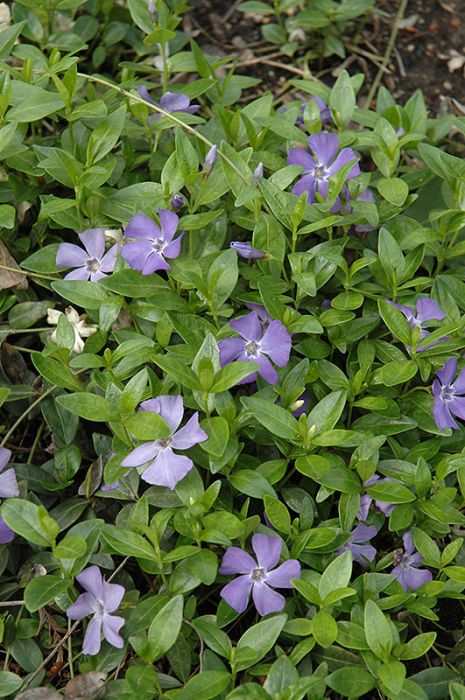Vinca, Myrtle Periwinkle



Out of stock
Sold out for the season- Sun Preference
- Full-Sun, No-Sun
- Bloom Time
- May, June
Description
One of the finest low-growing groundcovers for tough shade, featuring rich lavender flowers held over lustrous dark green evergreen foliage; does well in sun or deep shade, quickly forms a dense mat, even grows well under mature trees
Minnesota's Largest Selection of Perennials
Discover an unparalleled selection of perennials at Gertens! With the largest variety in Minnesota, we offer endless options of colorful perennials, natives, and pollinator plants to beautify your garden year after year. From vibrant flowers to lush foliage, our perennials are perfect for adding beauty and charm to your outdoor space. Visit Gertens today and see why we're known as Minnesota's Destination Garden Center!
Details
Height: 6 inches
Spread: 10 inches
Sunlight: ![]()
![]()
![]()
Hardiness Zone: 4a
Other Names: Creeping Myrtle, Vinca
Description:
One of the finest low-growing groundcovers for tough shade, featuring rich lavender flowers held over lustrous dark green evergreen foliage; does well in sun or deep shade, quickly forms a dense mat, even grows well under mature trees
Ornamental Features
Periwinkle has masses of beautiful purple flowers along the stems from mid to late spring, which are most effective when planted in groupings. Its small glossy oval leaves remain dark green in color throughout the year. The fruit is not ornamentally significant.
Landscape Attributes
Periwinkle is an herbaceous evergreen perennial with a ground-hugging habit of growth. Its medium texture blends into the garden, but can always be balanced by a couple of finer or coarser plants for an effective composition.
This is a high maintenance plant that will require regular care and upkeep, and should not require much pruning, except when necessary, such as to remove dieback. Deer don't particularly care for this plant and will usually leave it alone in favor of tastier treats. Gardeners should be aware of the following characteristic(s) that may warrant special consideration;
- Spreading
Periwinkle is recommended for the following landscape applications;
- Border Edging
- General Garden Use
- Groundcover
- Container Planting
Planting & Growing
Periwinkle will grow to be only 6 inches tall at maturity, with a spread of 10 inches. Its foliage tends to remain low and dense right to the ground. It grows at a fast rate, and under ideal conditions can be expected to live for approximately 10 years.
This plant performs well in both full sun and full shade. It prefers to grow in average to moist conditions, and shouldn't be allowed to dry out. It is not particular as to soil type or pH. It is highly tolerant of urban pollution and will even thrive in inner city environments, and will benefit from being planted in a relatively sheltered location. Consider covering it with a thick layer of mulch in winter to protect it in exposed locations or colder microclimates. This species is not originally from North America. It can be propagated by division.
Periwinkle is a fine choice for the garden, but it is also a good selection for planting in outdoor pots and containers. Because of its spreading habit of growth, it is ideally suited for use as a 'spiller' in the 'spiller-thriller-filler' container combination; plant it near the edges where it can spill gracefully over the pot. Note that when growing plants in outdoor containers and baskets, they may require more frequent waterings than they would in the yard or garden. Be aware that in our climate, most plants cannot be expected to survive the winter if left in containers outdoors, and this plant is no exception. Contact our store for more information on how to protect it over the winter months.
More Information
| Common Family Name | Periwinkle |
|---|---|
| Gerten Grown Plants | Gerten Grown Plants |
| Available for Pre-Order | No |
| Sun Preference | Full-Sun, No-Sun |
| Bloom Time | May, June |
| Mature Spread (Range) | Under 12" |
| Mature Height (Range) | 7-12" |
| USDA Hardiness Zone | 4, 5, 6, 7, 8 |


